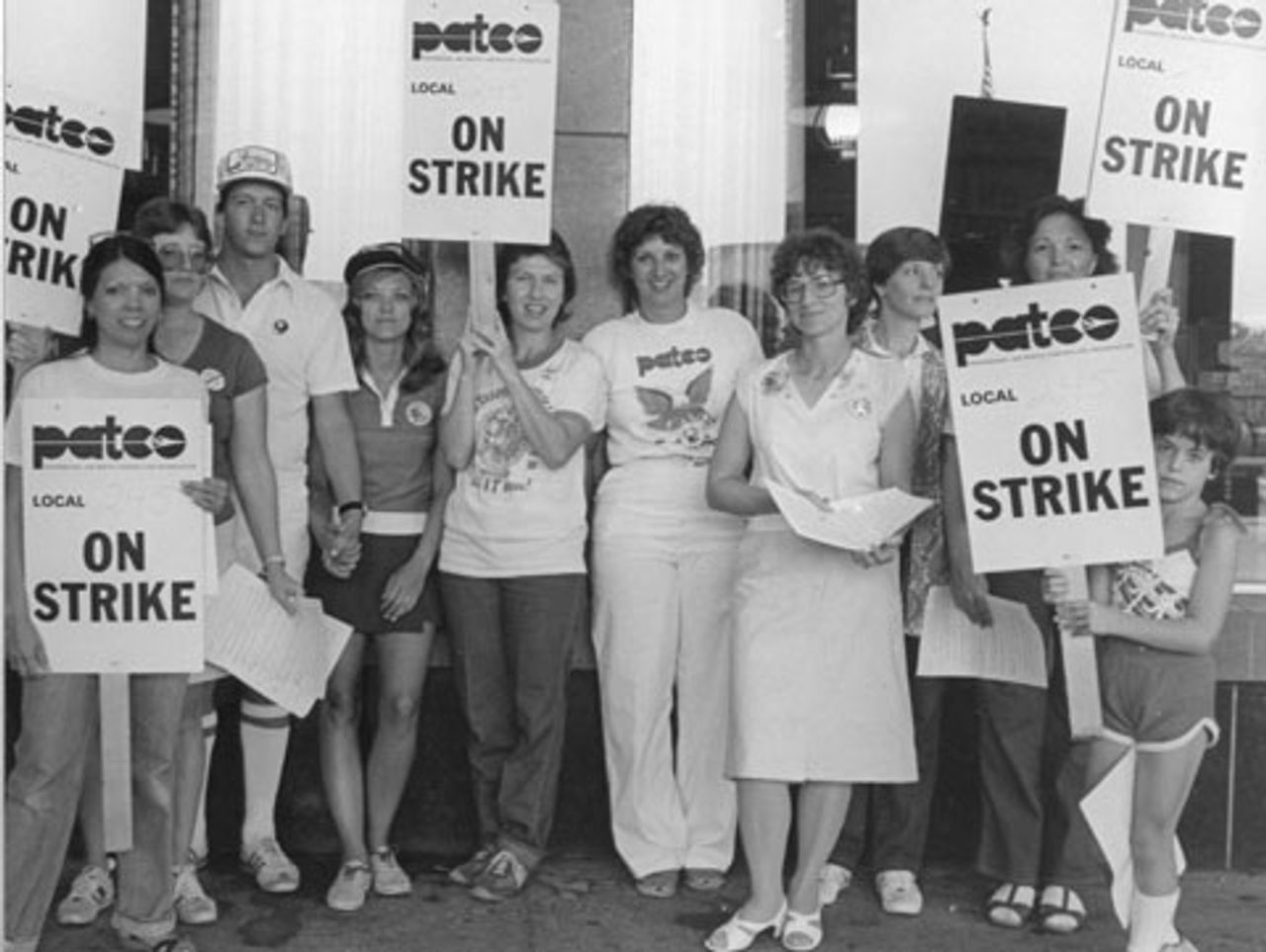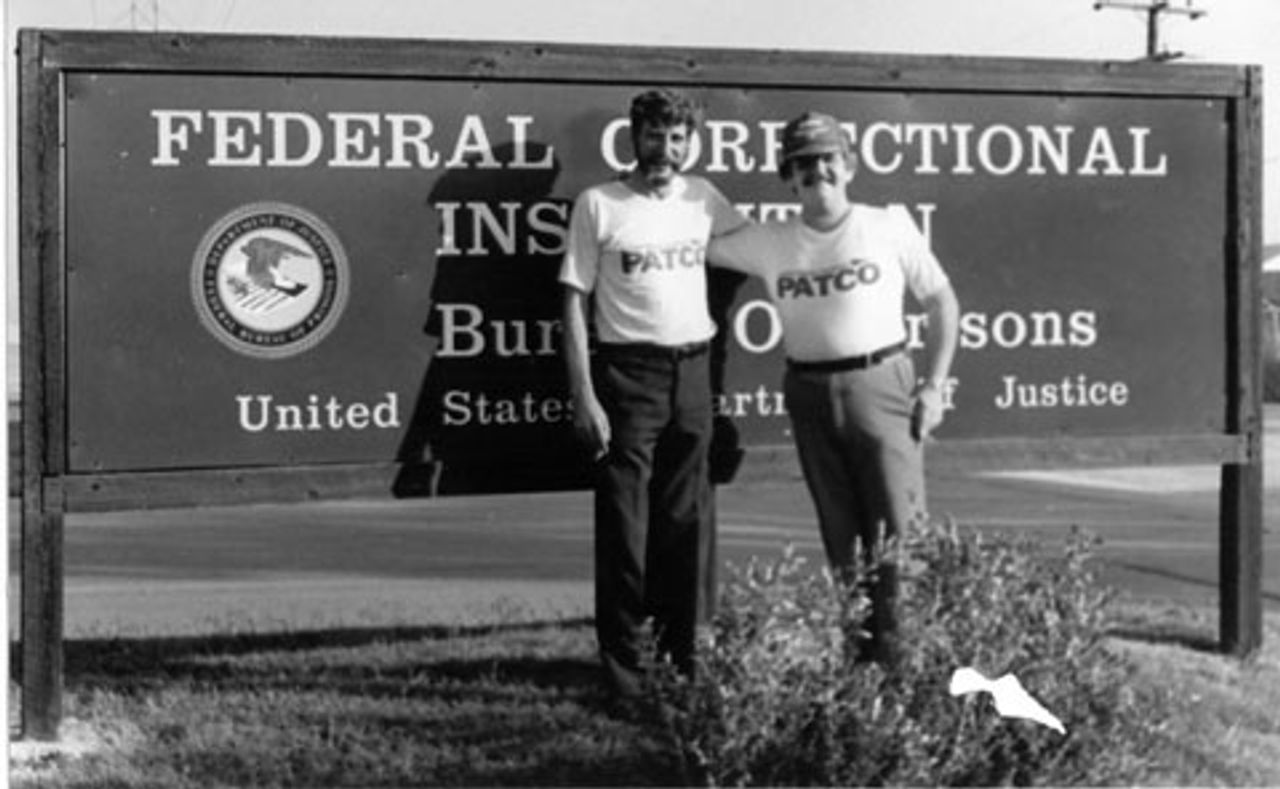PART ONE | PART TWO | PART THREE | PART FOUR | PART FIVE
 PATCO strikers and family members on the picket line
PATCO strikers and family members on the picket lineThe American ruling class never forgave the air traffic controllers for the determined stand they took against the attacks of the Reagan administr ation.
Five years after the strike, on August 3, 1986, Republican Congressman Guy Molinari introduced a modest measure that would have allowed 1,000 of the 12,000 blackballed PATCO workers to apply for jobs as FAA air traffic controllers. The measure was defeated by the Democratic Party-controlled House of Representatives by a margin of 226-193.
The ban on the rehiring of PATCO strikers, imposed by Reagan and a Democratic-controlled Congress, was officially lifted by the Clinton administration in 1993. But even after this, less than 10 percent of those fired were ever rehired.
The union that replaced PATCO in the airline industry, the National Air Traffic Controllers Association (NATCA), was an organization created and controlled by strikebreakers and sanctioned by the Reagan administration. From its inception it promised that it would never carry out an “illegal” strike as PATCO had—in other words, it would never authorize a strike at all.
The conditions of overwork and fatigue that gave rise to the strike have only worsened. Last April, a scandal was whipped up by the media over incidents of air traffic controllers falling asleep on the job. President Obama was quick to join in scape-goating the controllers.
“The individuals who are falling asleep on the job, that’s unacceptable,” Obama said. “The fact is, when you’re responsible for the lives and safety of people up in the air, you better do your job. So, there’s an element of individual responsibility that has to be dealt with.”
The most significant case took place on March 23, when American Airlines flight 1012 from Miami and United Airlines flight 628 from Chicago each requested permission to land at Ronald Reagan Washington National Airport. After repeated attempts to signal the control tower, the flights were forced to land unassisted. No one was hurt among the some 165 passengers and crew on the two flights. After this incident came to public attention, it was revealed that there had been a number of other cases of controllers dozing off over the past year.
In early 2008 there were 11,000 FAA air traffic controllers in the US—less than the number working in the industry at the time of the PATCO strike. The consequences of this severe understaffing were tragically revealed in 2006 in Lexington, Kentucky, when a Comair Flight crashed after attempting to take off from the wrong runway, killing all 47 passengers and two of the three-member crew. After correctly giving the plane its runway assignment, the lone air traffic controller on duty had proceeded to other tasks, as required by FAA protocol.
A study by the National Transportation Safety Board (NTSB) four years ago found that 61 percent of air traffic controllers had work schedules that “opposed normal sleep-wake patterns.” Bloomberg News reported: “A schedule may look like this: The first day, a 3 pm shift start; the second day, a 2 pm start; the third day, 7 am; the fourth day, 6 am. The worker may return to work a fifth shift at 10 pm on the fourth day to get a longer weekend, the board said.”
Many air traffic controllers have only eight hours off between shifts, which leaves only a few hours for sleeping.
Other elements of the nation’s airline infrastructure and regulatory system are in an advanced state of decay. The FAA, which has suffered significant budget cutbacks, has only 1,100 inspectors to look after 625,000 pilots, 5,200 repair stations and 81 airlines.
The reckless subordination of the health and safety of travelers and air industry workers to budget-cutting has once again come into focus in the recent shut-down of the FAA. While air traffic controllers were exempted from the shutdown, FAA safety inspectors were furloughed, along with tens of thousands of construction workers. The FAA has been operating without a long-term budget since 2007, depending instead on short-term approvals. (See: “Funding deadlock cripples US aviation agency”.)
Conclusion
The PATCO strike announced the definitive end of the period of relative class compromise and social reform that had prevailed in the US and other advanced industrial countries since the end of World War II. From that moment on, the capitalist class has carried out a relentless offensive to roll back the gains the working class realized over decades of struggle.
 PATCO leaders Dick Hoover and Ron May stand outside the federal prison in Texas
PATCO leaders Dick Hoover and Ron May stand outside the federal prison in TexasAs the Workers League Political Committee explained just ten days into the PATCO strike in a statement published in the Bulletin, entitled “The PATCO Strike: A Warning to the Working Class”:
The strike by 13,000 members of the Professional Air Traffic Controllers Organization is a historical turning point for the struggle of the working class in the United States and internationally. It is the first major political confrontation between the American working class and the government.
After decades in which the class struggle in America was either denied entirely or minimized, in which the American worker was depicted as having become the middle class, in which America was held up as the great exception in a world in revolutionary ferment, the PATCO strike has exploded all these myths.
The air controllers’ strike has demonstrated that underneath the appearance of political stability and conservatism, the most insoluble social and economic contradictions of any capitalist country have been building up....
At the same time, the mask of democracy and government “of the people, by the people and for the people” is being stripped off, and the capitalist state is revealing itself for what it is: an instrument of oppression of the masses in the interests of a tiny handful of billionaires.
Workers are thrown in jail, bound hand and foot with chains; their union is decertified for doing what 95 percent of the members voted to do; punitive fines have been levied aimed at confiscating all the assets of the union and handing them over to the government or the airlines; FBI agents and federal marshals monitor picket lines and visit workers in their homes to intimidate them and their families.
One political conclusion above all must be drawn from the PATCO strike: far from being an aberration or exception, it reveals the real essence of class relations in the United States.
The ruling class is attacking all the basic rights of workers—social services, jobs, safety regulations, living standards, and now the right to union organization—and calling upon the repressive powers and violence of the capitalist state to enforce these attacks.
The ruling class relies on the trade union bureaucrats to sabotage the fight of the working class against the government. This sabotage takes the form, not only of open strikebreaking as in the air traffic controllers’ struggle, but most of all keeping the working class politically disenfranchised by supporting the capitalist two-party system.
This onslaught has been dramatically intensified in the past few years. Having funneled untold trillions of dollars to the major banks and finance houses to cover their bad debts, governments all over the world are now demanding unprecedented cuts to social spending. No allocation of resources is permissible—for pensions, health care, education, infrastructure— that does not grow the cash hordes of the worlds’ banks, corporations and billionaires.
The unions and all the old organizations of the working class have played the critical role in this social retrogression. The AFL-CIO’s complicity with the Reagan administration and its rejection of popular rank-and-file demands for broadening the PATCO struggle set the pattern for all the US labor struggles in the 1980s and 1990s. In case after case the unions isolated, betrayed and helped defeat strikes, in spite of bitter working class resistance.
The same process unfolded all over the world, perhaps most similarly in the United Kingdom, where in 1985 the Trades Union Congress (TUC) looked on as Prime Minister Margaret Thatcher crushed the coalminers, setting the stage for the destruction of industry and working class living standards.
Everywhere the old labor and Social Democratic parties completely embraced the demands of the financiers and helped line the pockets of the rich by impoverishing workers. In Africa, Latin America and Asia the old national liberation movements followed the same path, scrapping import-substitution plans and nationalized industry and competing with each other over who could provide imperialism with the cheapest labor and most lucrative natural resources.
The most far-reaching example of this sea-change took place in the Soviet Union. As Leon Trotsky had warned more than 50 years earlier, the Stalinist bureaucracy dismantled the property relations established by the October 1917 Revolution, converting itself into a new capitalist class.
The tie that binds these processes is the transformation of nationally-based labor bureaucracies and political parties from formations that within narrow limits defended the interests of workers into open instruments of class oppression. Underlying this, in turn, was the unprecedented global integration of production, which had intensified the contradiction between global economy and the nation state and rendered all nationalist programs impotent and reactionary.
In the US, the official unions consciously responded to the decline in the world economic position of American capitalism by offering their services to the corporate-financial elite, collaborating in the drive to make American corporations globally competitive at the direct expense of the jobs, wages and working conditions of US workers.
The Workers League analyzed these developments and concluded by the beginning of the 1990s that the official unions could no longer be considered in any genuine sense to be workers’ organizations, even in a limited defensive sense. Drawing out the implications of the collapse of the trade unions and the final counterrevolutionary betrayal of the Soviet bureaucracy, the Workers League and its co-thinkers in the International Committee of the Fourth International (ICFI) made the decision in the 1990s to transform themselves from leagues into parties.
It was now the turn of the world Trotskyist movement, the International Committee of the Fourth International and the Socialist Equality Party in the US, to fight directly for the leadership of the working class in preparation for the revolutionary struggles that would inevitably ensue. The Wall Street crash of 2008 has ushered in this new period of revolutionary struggle.
Subscribe to the IWA-RFC Newsletter
Get email updates on workers’ struggles and a global perspective from the International Workers Alliance of Rank-and-File Committees.
